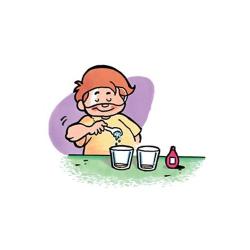Source Institutions
Source Institutions
Add to list Go to activity

In this introductory activity, learners discover that sugar and food coloring dissolve in water but neither dissolves in oil. Based on their observations, learners can conclude that both solids and liquids can dissolve, but they don't necessarily dissolve in all liquids. Through this activity, learners will refine their definition of dissolve. [Activity is publicly available through a web crawler capture on Archive.org. Activity write-up only, images are unavailable.]
- Under 5 minutes
- 10 to 30 minutes
- 1 cent - $1 per group of students
- Ages 8 - 14
- Activity, Experiment/Lab Activity, Lesson/Lesson Plan
- English
Quick Guide
Materials List (per group of students)
- Water
- Vegetable Oil
- Sugar
- Food Coloring
- 2 Small cups
- 4 Clear plastic cups
- 1 Tablespoon
- 1 Teaspoon
- Student Activity Sheet
- Goggles
Subjects
-
Physical Sciences
-
Chemistry
- Solutions
-
States of Matter
- Solids
- Liquids
- Gases
- Changes of Phase
-
Structure and Properties of Matter
- Elementary Particles and Nuclear Physics
-
Chemistry
-
The Nature of Science
-
The Scientific Process
- Conducting Investigations
- Gathering Data
- Formulating Explanations
- Communicating Results
-
The Scientific Process
Informal Categories
- Food and Cooking
Audience
To use this activity, learners need to:
- see
- see color
- touch
Learning styles supported:
- Involves hands-on or lab activities
Other
Components that are part of this resource:
This resource is part of:
Access Rights:
- Free access
By:
- Kessler, James H. ; Galvan, Patricia M.
Rights:
- All rights reserved, American Chemical Society, 2007
